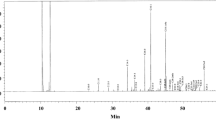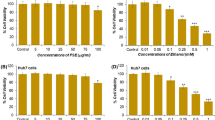Abstract
2′,4′-Dihydroxy-6′-methoxy-3′,5′-dimethylchalcone (DMC) is a chalcone isolated from the buds of Cleistocalyx operculatus (Roxb.) Merr. et Perry, and the hepatoprotective effects of DMC on Kunming mice have been studied in previous study. However, the effects of DMC on hepatocyte toxicity and corresponding mechanism remain unclear. The aim of this study was to evaluate the hepatoprotective mechanism of DMC in human hepatocytes (L02) treated with H2O2. The results demonstrated that pretreatment with DMC effectively protected H2O2-induced cell viability loss, cell membrane damage (lactate dehydrogenase, nitric oxide production and caspase-3 accumulation. Besides, DMC pretreatment increased the amount of glutathione, decreased malondialdehyde and the percentage of apoptotic L02 cells compared with only H2O2 treated group. Taken together, these results indicated that DMC had hepatoprotective effects against H2O2-induced liver injury by alleviating oxidative stress and apoptosis process in L02 cells, and DMC might be a potential candidate for the intervention of liver diseases.






Similar content being viewed by others
Abbreviations
- DMC:
-
2′,4′-Dihydroxy-6′-methoxy-3′,5′-dimethylchalcone
- MTT:
-
3-(4,5-Dimethylthiazol-2-yl)-2,5-diphenyltetrazoliumbromide
- LDH:
-
Lactate dehydrogenase
- MDA:
-
Malondialdehyde
- ROS:
-
Reactive oxygen species
- GSH:
-
Reduced glutathione
- GSH-PX:
-
Glutathione peroxidase
- GST:
-
Glutathione-S-transferase
- AV:
-
Annexin V
- PI:
-
Propidineiodide
References
Amor, E.C., and I.M. Villasenor. 2005. Spasmolytic flavonoids from Syzygium samarangense (Blume) Merr. & L.M. Perry. Zeitschrift fur Naturforschung C 60: 67–71.
An, R., D. Sohn, G. Jeong, and Y. Kim. 2008. In vitro hepatoprotective compounds from Suaeda glauca. Archives of Pharmacal Research 31: 594–597.
Bell, E.F. 1987. History of vitamin E in infant nutrition. The American Journal of Clinical Nutrition 46: 183–186.
Budihardjo, I., H. Oliver, and M. Lutter. 1999. Biochemical pathways of caspase activation during apoptosis. Annual Review of Cell and Developmental Biology 15: 269–290.
Burton, G.W. 1990. Vitamin E: Antioxidant activity, biokinetics, and bioavailability. Annual Review of Nutrition 10: 357–382.
Chen, M., H. Gu, Y. Ye, B. Lin, L. Sun, W. Deng, J. Zhang, and J. Liu. 2010. Protective effects of hesperidin against oxidative stress of tert-butyl hydroperoxide in human hepatocytes. Food and Chemical Toxicology: An International Journal Published for the British Industrial Biological Research Association 48: 2980–2987.
Cohen, G.M. 1997. Caspases: the executioners of apoptosis. The Biochemical Journal 326: 1–16.
Cole, K.K., and J.R. Perez-Polo. 2002. Poly(ADP-ribose) polymerase inhibition prevents both apoptotic-like delayed neuronal death and necrosis after H2O2 injury. Journal of Neurochemistry 82: 19–29.
Coyle, C.H., L.J. Martinez, M.C. Coleman, D.R. Spitz, N.L. Weintraub, and K.N. Kader. 2006. Mechanisms of H2O2-induced oxidative stress in endothelial cells. Free Radical Biology & Medicine 40: 2206–2213.
Das, K., and P. Kar. 2005. Non-alcoholic steatohepatitis. J Assoc Physicians India 53: 50–59.
Dung, N.T., J.M. Kim, and S.C. Kang. 2008. Chemical composition, antimicrobial and antioxidant activities of the essential oil and the ethanol extract of Cleistocalyx operculatus (Roxb.) Merr and Perry buds. Food and Chemical Toxicology: An International Journal Published for the British Industrial Biological Research Association 46: 3632–3639.
Englert, R.P., and E. Shacter. 2002. Distinct modes of cell death induced by different reactive oxygen species: amino acyl chloramines mediate hypochlorous acid-induced apoptosis. The Journal of Biological Chemistry 277: 20518–20526.
Guevaraa, I., and J. Iwanejkoa. 1998. Determination of nitrite/nitrate in human biological material by the simple Griess reaction. Clinica Chimica Acta 274: 177–188.
Huang, H., J. Niu, L. Zhao, and Y.H. Lu. 2011. Reversal effect of 2′,4′-dihydroxy-6′-methoxy-3′,5′-dimethylchalcone on multi-drug resistance in resistant human hepatocellular carcinoma cell line BEL-7402/5-FU. Phytomedicine: International Journal of Phytotherapy and Phytopharmacology 18: 1086–1092.
Jaeschke, H. 2000. Reactive oxygen and mechanisms of inflammatory liver injury. Journal of Gastroenterology and Hepatology 15: 718–724.
Jia, Z., and H.P. Misra. 2007. Reactive oxygen species in in vitro pesticide-induced neuronal cell (SH-SY5Y) cytotoxicity: Role of NF-κB and caspase-3. Free Radical Biology & Medicine 42: 288–298.
Kang, K.S., I.D. Kim, R.H. Kwon, J.Y. Lee, J.S. Kang, and B.J. Ha. 2008. The effects of fucoidan extracts on CCl(4)-induced liver injury. Archives of Pharmacal Research 31: 622–627.
Kim, Y.J., H. Ko, J. Park, I. Han, E.C. Amor, J. Wha, and H. Ok. 2010. Dimethyl cardamonin inhibits lipopolysaccharide-induced inflammatory factors through blocking NF-κB p65 activation. International Immunopharmacology 10: 1127–1134.
Kruman, I.I., and M.P. Mattson. 1999. Pivotal role of mitochondrial calcium uptake in neural cell apoptosis and necrosis. Journal of Neurochemistry 72: 529–540.
Lin, F.Y., P.L. Liu, Y.T. Huang, J.H. Chiu, Y.C. Chang, K.M. Man, C.Y. Hong, Y.Y. Ho, M.T. Lai, and Y.H. Chen. 2009. Antioxidative and hepatoprotective effects of acteaminophen on acetaminophen-induced liver damage in rats. Archives of pharmacal research 32: 221–228.
Loguercio, C., and A. Federico. 2003. Oxidative stress in viral and alcoholic hepatitis. Free Radical Biology & Medicine 34: 1–10.
Manev, H., C.M. Cagnoli, and C. Atabay. 1995. Neuronal apoptosis in an in vitro model of photochemically induced oxidative stress. Experimental Neurology 133: 198–206.
Moriya, K., K. Nakagawa, T. Santa, V. Hepatocarcinogenesis, Y. Shintani, H. Fujie, and H. Miyoshi. 2001. Oxidative stress in the absence of inflammation in a mouse model for hepatitis C virus-associated hepatocarcinogenesis oxidative stress in the absence of inflammation in a mouse model for hepatitis C. Cancer Research 61: 4365–4370.
Qiao, L., J. Yu, P. Dent, and G. Farrell. 2005. NF-κB protects rat ARL-6 hepatocellular carcinoma cells against hydrogen peroxide-induced apoptosis. Cancer Biology & Therapy 4: 1195–1202.
Resurreccion, M.C., I.M. Villasenor, N. Harada, and K. Monde. 2005. Antihyperglycaemic flavonoids from Syzygium samarangense (Blume) Merr. and Perry. Phytotherapy Research 19: 246–251.
Samali, A., H. Nordgren, B. Zhivotovsky, E. Peterson, and S. Orrenius. 1999. A comparative study of apoptosis and necrosis in HepG2 cells: oxidant-induced caspase inactivation leads to necrosis. Biochemical and Biophysical Research Communications 255: 6–11.
Su, M.Y., H.Y. Huang, L. Li, and Y.H. Lu. 2011. Protective effects of 2′,4′-dihydroxy-6′-methoxy-3′,5′-dimethylchalcone to PC12 cells against cytotoxicity induced by hydrogen peroxide. Journal of Agricultural and Food Chemistry 59: 521–527.
Takahashi, M., M. Shibata, and E. Niki. 2001. Estimation of lipid peroxidation of live cells using a fluorescent probe, diphenyl-1-pyrenylphosphine. Free Radical Biology & Medicine 31: 164–174.
Traber, M.G., and J.F. Stevens. 2011. Vitamins C and E: beneficial effects from a mechanistic perspective. Free Radical Biology and Medicine 51:1000–1013.
Tribble, D.L., T.Y. Aw, and D.P. Jones. 1987. The pathophysiological significance of lipid peroxidation in oxidative cell injury. Hepatology 7: 377–386.
Valko, M., and D. Leifbritz. 2007. Free radicals and antioxidants in normal physiological functions and human disease. The International Journal of Biochemistry & Cell Biology 39: 44–84.
Veigas, J.M., R. Shrivasthava, and B. Neelwarne. 2008. Efficient amelioration of carbon tetrachloride induced toxicity in isolated rat hepatocytes by Syzygium cumini Skeels extract. Toxicology In Vitro 22: 1440–1446.
Weng, D., Y. Lu, Y. Wei, Y. Liu, and P. Shen. 2007. The role of ROS in microcystin-LR-induced hepatocyte apoptosis and liver injury in mice. Toxicology 232: 15–23.
Ye, C.L., J.W. Liu, D.Z. Wei, Y.H. Lu, and F. Qian. 2005. In vivo antitumor activity by 2′4′-dihydroxy-6′-methoxy-3′5′-dimethylchalcone in a solid human carcinoma xenograft model. Cancer Chemotherapy and Pharmacology 55: 447–452.
Ye, C.L., Y.H. Lu, and D.Z. Wei. 2004a. Flavonoids from Cleistocalyx operculatus. Phytochemistry 65: 445–447.
Ye, C.L., J.W. Liu, D.Z. Wei, Y.H. Lu, and F. Qian. 2004b. In vitro anti-tumor activity of 2′,4′-dihydroxy-6′-methoxy-3′,5′-dimethylchalcone against six established human cancer cell lines. Pharmacological Research 50: 505–510.
Yu, W.G., J. Qian, and Y.H. Lu. 2011. Hepatoprotective effects of 2′, 4′-dihydroxy-6′-methoxy-3′,5′-dimethylchalcone on CCl4-induced acute liver injury in mice. Journal of Agricultural and Food Chemistry 59: 12821–12829.
Acknowledgments
This work was supported by “the Fundamental Research Funds for the Central Universities”, and partially supported by the National Special Fund for State Key Laboratory of Bioreactor Engineering (2060204), Shanghai Leading Academic Discipline Project (B505), and the 863 Project (2011AA090702).
Author information
Authors and Affiliations
Corresponding author
Rights and permissions
About this article
Cite this article
Lu, Y., Zhang, YY., Hu, YC. et al. Protective effects of 2′,4′-dihydroxy-6′-methoxy-3′,5′-dimethylchalcone against hydrogen peroxide-induced oxidative stress in hepatic L02 cell. Arch. Pharm. Res. 37, 1211–1218 (2014). https://doi.org/10.1007/s12272-014-0334-4
Received:
Accepted:
Published:
Issue Date:
DOI: https://doi.org/10.1007/s12272-014-0334-4




